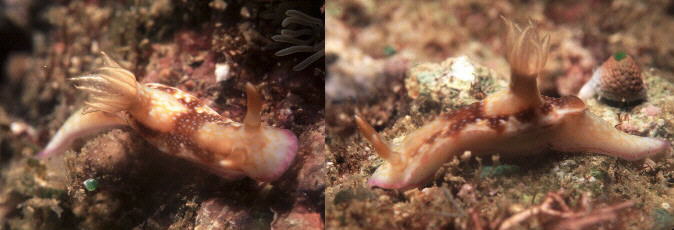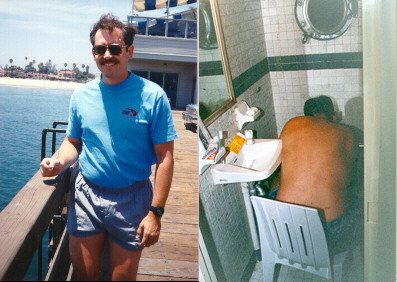 |
Hypselodoris reidi
Batangas, Philippines, April 1998
Hypselodoris reidi Gosliner & Johnson, 1999
This Branch of the Week feature is the first to discuss the twelve new species of Hypselodoris described in a recent monograph by my colleague Terry Gosliner and the lovely and talented Rebecca Johnson (see reference below). Let me introduce you first to Hypselodoris reidi.. The specific name for Hypselodoris reidi was chosen to recognize David Reid of Oxnard, California, dear friend and discoverer of this unique chromodorid nudibranch. Dave Reid completely fills the bill as the mild mannered reporter for the Daily Planet. Behind his stately conservation attire and demeanor lies a hella-of-a, well - a humble and accomplished underwater photographer. Dave - a good buddy and member of our 1995 Philippines expedition, is also the co-owner, with wife and uw photographer extrordinaire, Terry Schuller, of UltraLight Control Systems, offering quality UW strobe accessories to the diving community. Both were generous photo contributors to Coral Reef Animals of the Indo-Pacific.
Dave was responsible for collecting the first pair of specimens of this Hypselodoris on our 1995 collecting trip to Batangas Province in the Philippine Islands. As he climbed into our 'banca' and handed Gosliner a plastic baggie, I will never forget his asking "are these any good?" Terry and my mouths both dropped open. Well, I'd say so.
Hypselodoris reidi, as it is now referred to, is a typical long slender Hypselodoris with a white body, covered by a yellow reticulating pattern. It has a distinctive pink band along the margin of the head and tail. The notum bears a brown saddle with evenly distributed pinkish white spots. The gills and rhinophores are tan.
The type locality of H. reidi is that lonely little reef near Anilao Village on Luzon we refer to as "Bus Stop Reef." For those of you that follow this weekly column, you will recognize it as the type locality also for Chromodoris hintuanensis.
Collected again at the same location last year by Clay Carlson and Mike Miller, we still know very little about the species. Both collections were from about 40 feet deep and the specimens ranged from 25 to 50 mm in length.
So that's how it goes, be a nice person, be the first to collect specimens,
and you too can have your name carried into perpetuity on the back of a sea
slug.
Citation
Terrence M. Gosliner and Rebecca F. Johnson, 1999. Phylogeny of
Hyselodoris (Nudibranchia: Chromodorididae) with a review of the
monophyletic clade of Indo-Pacific species, including descriptions of
twelve new species.
Zool. Journ. Linnean Soc. 125:1-114, with 62
figures.

|
Dave Reid has been diving for 13 years. He was certified in the Monterey
area and has traveled extensively to many warmer areas of the world. The immediate photo to the left is Dave on E-6 duty during a trip to the Philippines in 1995
He began underwater photography soon after becoming certified. He has won and placed in many photography contests. He has also had some of his photos published in magazines and books. Dave shoots with a Nikon f4 in a Subal housing, using Sea and Sea strobes. His film of choice for macro work is Velvia. Four years ago, Dave and his wife Terry purchased UltraLight Control Systems, a manufacturer of camera arms and trays. They built the original pivot for still cameras and produce the lightest weight arms on the market today. The flexibility and staying power of UltraLight's arms means you will never have to purchase another set in your lifetime. Visit UltraLight's web site at UltraLight Control Systems . |
Taxonomic information courtesy of Dave Behrens

|
David W. Behrens
Author:
Pacific Coast Nudibranchs
Send Dave mail at seachalleng@earthlink.net
|
